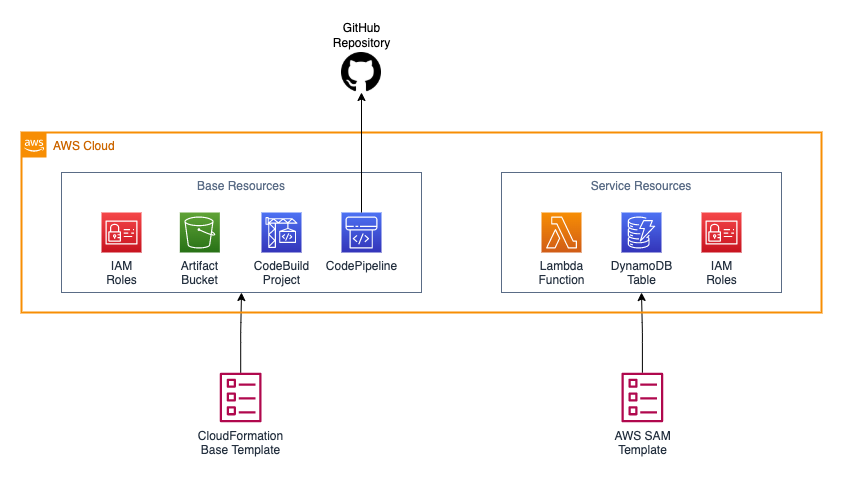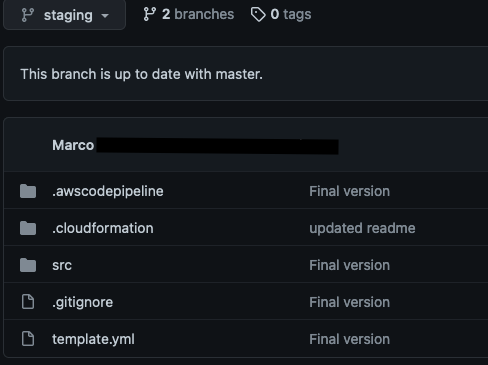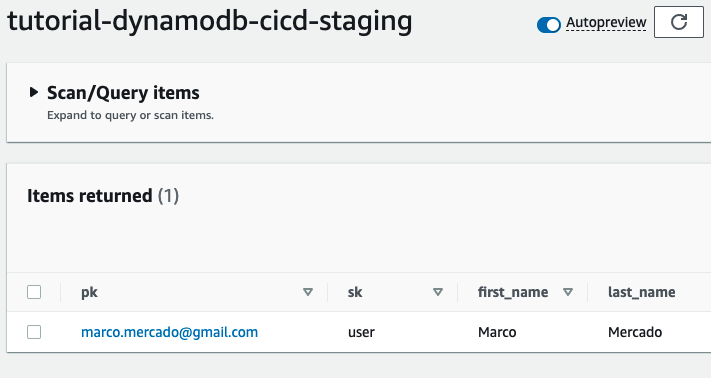AWS Lambda - CI/CD with AWS SAM, CodePipeline & CloudFormation
Complete example about how to implement a CI/CD workflow from an infrastructure as a code template

Introduction
In this guide, we're going to deploy an AWS Lambda function using CodePipeline & AWS SAM to continuously integrate and deploy our code changes to the cloud, but instead of using the AWS Management Console, we're going to write the in a CloudFormation template, by doing that you can easily provision infrastructure for every development environment and also you can implement it in every AWS SAM based project.
Architecture

As we can appreciate in the diagram of above, we're going to write 2 code templates, the first one will be a CloudFormation template and is going to be responsible of the base infrastructure that in this case is mainly the pipeline, the second one will be an AWS SAM template that will be the template that deploys our service infrastructure.
Tutorial
First, lets create a couple of files and directories to be in the same place:

We're going to start by writing our Lambda function code on the main.js file under the /src folder:
const AWS = require('aws-sdk')
let dynamodb = new AWS.DynamoDB.DocumentClient({ region: 'us-east-1'})
exports.handler = (event, context, callback) => {
let params = {
TableName: process.env.ddbTable,
Item: {
pk: "marco.mercado@gmail.com",
sk: "user",
first_name: "Marco",
last_name: "Mercado"
},
ConditionExpression: "attribute_not_exists(pk)",
ReturnConsumedCapacity: 'TOTAL'
}
dynamodb.put(params, (err, data) => {
if (err) callback(err)
else callback(null, data)
})
}The function is pretty simple, as we've seen in the DynamoDB Operations post we're performing a put operation into a DynamoDB table with the AWS SDK for NodeJS. The only thing that I want you to notice is that in the line 7 we're calling an environment variable for the DynamoDB table, that variable it's going to be defined in the SAM template.
NOTE: The package.json file is a default one in this example, can be created by simply running npm init -y
Now let's create the template.yml file in which we're going to use AWS SAM to deploy our serverless resources:
AWSTemplateFormatVersion: "2010-09-09"
Transform: AWS::Serverless-2016-10-31
Description: >
AWS SAM Lambda function example
Parameters:
Environment:
Type: String
Description: Environment name
Globals:
Function:
Timeout: 3
Resources:
DdbTable:
Type: AWS::DynamoDB::Table
DeletionPolicy: Retain
Properties:
TableName: !Sub tutorial-dynamodb-cicd-${Environment}
AttributeDefinitions:
- AttributeName: pk
AttributeType: S
- AttributeName: sk
AttributeType: S
KeySchema:
- AttributeName: pk
KeyType: HASH
- AttributeName: sk
KeyType: RANGE
BillingMode: PAY_PER_REQUEST
ProvisionedThroughput:
ReadCapacityUnits: 0
WriteCapacityUnits: 0
MainFunction:
Type: AWS::Serverless::Function
Properties:
FunctionName: !Sub sam-function-example-${Environment}
CodeUri: src/
Handler: main.handler
Runtime: nodejs12.x
Environment:
Variables:
ddbTable: !Ref DdbTable
Policies:
- Statement:
- Sid: DynamoDBPolicy
Effect: Allow
Action:
- dynamodb:PutItem
Resource:
- !GetAtt DdbTable.Arn
Outputs:
MainFunction:
Description: "Main Lambda Function ARN"
Value: !GetAtt MainFunction.ArnThe template is going to deploy a DynamoDB table with the environment as suffix to split resources by environment and a Lambda function with an IAM Role that allows it to write into the DynamoDB table.
Nice! at this moment we could deploy our function by using the AWS SAM CLI, but that would be a manual step, what we want is that any time a developer push code into the repository those changes will be automatically built and deployed.
The service in which the AWS SAM template is going to run is CodeBuild, knowing that we need to write the step by step instructions of how to build and deploy our project with AWS SAM, those instructions will be written in the buildspec.yml file under the .awscodepipeline folder like the following code:
version: 0.2
phases:
build:
commands:
- sam build -t template.yml
post_build:
commands:
- |
sam deploy --no-confirm-changeset --no-fail-on-empty-changeset \
--s3-bucket $CODEPIPELINE_BUCKET \
--s3-prefix $STACK_NAME \
--region $AWS_REGION \
--stack-name $STACK_NAME \
--capabilities CAPABILITY_IAM \
--parameter-overrides \
Environment=$ENVIRONMENTNow we have our components to set up our automation pipeline, the last step is to write our CloudFormation template located in the main.yml file under the .cloudformation directory, this is the longest part of the example so I'm going to break it in steps, if you want to look the entire file visit the link of the GitHub repository at the end of this post.
First as every template of CloudFormation we define the version and write a brief description about the template:
AWSTemplateFormatVersion: '2010-09-09'
Description: 'CloudFormation template to create an automation pipeline for AWS SAM projects'Next, we define our parameters:
Parameters:
FunctionName:
Type: String
Description: Name of the function to deploy with the pipeline
Environment:
Type: String
Description: Environment name
GitHubRepo:
Type: String
Description: GitHub repository name
GitHubUser:
Type: String
Description: GitHub user name
GitHubOAuthToken:
Type: String
Description: GitHub auth token
Resources:Now, we're going to write which resources this template is going to create, first of all we're going to define the IAM Roles that CodePipeline and CodeBuild are going to assume in order to have the necessary permissions:
NOTE: At this point every block of code will be indented under Resources
For CodeBuild:
CodeBuildServiceRole:
Type: AWS::IAM::Role
Properties:
Path: /
AssumeRolePolicyDocument:
Version: "2012-10-17"
Statement:
- Effect: Allow
Principal:
Service: codebuild.amazonaws.com
Action: sts:AssumeRole
Policies:
- PolicyName: "SAM"
PolicyDocument:
Version: "2012-10-17"
Statement:
- Effect: Allow
Action:
- dynamodb:DescribeTable
- dynamodb:CreateTable
- dynamodb:DeleteTable
Resource: '*'
- Effect: Allow
Action:
- cloudformation:CreateChangeSet
- cloudformation:DescribeChangeSet
- cloudformation:ExecuteChangeSet
- cloudformation:DescribeStackEvents
- cloudformation:DescribeStacks
- cloudformation:GetTemplateSummary
- cloudformation:UpdateStack
Resource: '*'
- Effect: Allow
Action:
- lambda:AddPermission
- lambda:CreateFunction
- lambda:DeleteFunction
- lambda:GetFunction
- lambda:GetFunctionConfiguration
- lambda:ListTags
- lambda:RemovePermission
- lambda:TagResource
- lambda:UntagResource
- lambda:UpdateFunctionCode
- lambda:UpdateFunctionConfiguration
Resource: arn:aws:lambda:*:*:function:*
- Effect: Allow
Action:
- iam:PassRole
Resource: "*"
Condition:
StringEquals:
iam:PassedToService: lambda.amazonaws.com
- Effect: Allow
Action:
- iam:CreateRole
- iam:DetachRolePolicy
- iam:PutRolePolicy
- iam:AttachRolePolicy
- iam:DeleteRole
- iam:GetRole
Resource: "arn:aws:iam::*:role/*"
- PolicyName: "logs"
PolicyDocument:
Version: "2012-10-17"
Statement:
- Effect: Allow
Action:
- logs:CreateLogGroup
- logs:CreateLogStream
- logs:PutLogEvents
- ssm:GetParameters
Resource: '*'
- PolicyName: "S3"
PolicyDocument:
Version: "2012-10-17"
Statement:
- Effect: Allow
Action:
- s3:GetObject
- s3:PutObject
- s3:GetObjectVersion
Resource: !Sub arn:aws:s3:::${ArtifactBucket}/*For CodePipeline:
CodePipelineServiceRole:
Type: AWS::IAM::Role
Properties:
Path: /
AssumeRolePolicyDocument:
Version: 2012-10-17
Statement:
- Effect: Allow
Principal:
Service: codepipeline.amazonaws.com
Action: sts:AssumeRole
Policies:
- PolicyName: root
PolicyDocument:
Version: 2012-10-17
Statement:
- Resource:
- !Sub arn:aws:s3:::${ArtifactBucket}/*
- !Sub arn:aws:s3:::${ArtifactBucket}
Effect: Allow
Action:
- s3:*
- Resource: "*"
Effect: Allow
Action:
- codebuild:StartBuild
- codebuild:BatchGetBuilds
- iam:PassRole
- Resource: "*"
Effect: Allow
Action:
- codecommit:CancelUplodaArchive
- codecommit:GetBranch
- codecommit:GetCommit
- codecommit:GetUploadArchiveStatus
- codecommit:UploadArchiveNext, we're going to create an S3 bucket to store our artifacts:
ArtifactBucket:
Type: AWS::S3::Bucket
DeletionPolicy: DeleteNow, we need a CodeBuild project, remember that CodeBuild is a compute instance managed by that will perform a list of steps to build your project, so we need to configure that instance:
CodeBuildProject:
Type: AWS::CodeBuild::Project
Properties:
Artifacts:
Type: CODEPIPELINE
Source:
Type: CODEPIPELINE
BuildSpec: .awscodepipeline/buildspec.yml
Environment:
ComputeType: BUILD_GENERAL1_SMALL
Image: aws/codebuild/amazonlinux2-x86_64-standard:2.0
Type: LINUX_CONTAINER
EnvironmentVariables:
- Name: CODEPIPELINE_BUCKET
Type: PLAINTEXT
Value: !Ref ArtifactBucket
- Name: STACK_NAME
Type: PLAINTEXT
Value: !Sub ${FunctionName}-${Environment}
- Name: ENVIRONMENT
Type: PLAINTEXT
Value: !Ref Environment
Name: !Ref AWS::StackName
ServiceRole: !Ref CodeBuildServiceRoleFinally, we put everything together in a CodePipeline pipeline, remember that CodePipeline it's an orchestration service, in this example is coordinating the GitHub repository as a source of our code with our CodeBuild project that is going to deploy our serverless resources.
Pipeline:
Type: AWS::CodePipeline::Pipeline
Properties:
Name: !Sub ${FunctionName}-${Environment}
RoleArn: !GetAtt CodePipelineServiceRole.Arn
ArtifactStore:
Type: S3
Location: !Ref ArtifactBucket
Stages:
- Name: Source
Actions:
- Name: Function
ActionTypeId:
Category: Source
Owner: ThirdParty
Version: '1'
Provider: GitHub
Configuration:
Owner: !Ref GitHubUser
Repo: !Ref GitHubRepo
Branch: !Ref Environment
OAuthToken: !Ref GitHubOAuthToken
RunOrder: 1
OutputArtifacts:
- Name: SourceArtifact
- Name: Build
Actions:
- Name: Build
ActionTypeId:
Category: Build
Owner: AWS
Version: '1'
Provider: CodeBuild
Configuration:
ProjectName: !Ref CodeBuildProject
InputArtifacts:
- Name: SourceArtifact
OutputArtifacts:
- Name: BuildArtifact
RunOrder: 2Before you deploy the project be sure that you have your code updated in a GitHub repository in a branch that matches the name of the environment that you're going to pick (ie. staging).

Now we can deploy our project with the following command using the AWS CLI:
NOTE: It is important that at this point you have the AWS CLI previously installed and your GitHub OAuth Access token, if you don't know how to generate your token or how to install the AWS CLI I'll leave you a couple of useful links.
Generate GitHub OAuth Access Token
aws cloudformation create-stack \
--stack-name lambda-cicd-post \
--template-body file://.cloudformation/main.yml \
--parameters \
ParameterKey=FunctionName,ParameterValue=<LAMBDA_FUNCTION_NAME> \
ParameterKey=Environment,ParameterValue=<ENVIRONMENT> \
ParameterKey=GitHubUser,ParameterValue=<GITHUB_USER> \
ParameterKey=GitHubRepo,ParameterValue=<REPO_NAME> \
ParameterKey=GitHubOAuthToken,ParameterValue=<GITHUB_OAUTH_TOKEN> \
--region us-east-1 \
--capabilities CAPABILITY_IAMThe following things should happen:
The stack should succesfully finish in CloudFormation:

Should create a CodePipeline pipeline that immediately triggers its first run:

That first run should create the following stack:

And now you should be able to test your function:



And that's it for this tutorial, remember that the entire code will be here, see you the next time!.

